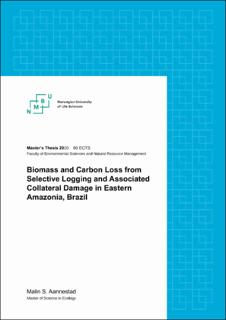| dc.description.abstract | Tropical forests are pivotal in global climate regulation and biodiversity conservation. Even though the value of tropical forests has been shown multiple times, they are still experiencing multiple pressures, threatening their existence. Timber industry is one of them, with over half of the world’s tropical forests having already been logged. Production for timber has increased in recent years, and in 2017 and 2018, 29 million m3 of roundwood was extracted from the Brazil alone. There have been many studies on the effect of selective logging, but few on collateral damage and the associated biomass and carbon loss. I sought to close this knowledge gap by investigating the direct and collateral biomass and carbon loss within a logging concession in Caxiuanã National Forest, Brazil.
I found that each extracted tree in the concession damaged on average 18.5 trees in the residual stand. The damaged trees were mostly of smaller DBH (diameter at breast height) classes. Loss of more than 2/3 of the crown was found for 33.5% of the residual trees, however most of the damage to the crown and bole was found to be bark scrapes without any damage to the cambial tissue, while the roots of the tree were most often uninjured. From the extracted trees and broken parts of residual trees I calculated a mean biomass and carbon loss per extracted tree of 9.11 ± 0.20 Mg and 4.29 ± 0.88 Mg, respectively. To see the impact of this result, I scaled this up for the 4 552 trees to be extracted within the concession. This led to an estimate of 41 468.7 Mg biomass and 19 531 ± 8542 carbon lost during operations. My results show that even best-case scenarios of logging with the Brazilian Amazon are highly damaging, and further research needs to focus on methods to reduce collateral damage and associated biomass and carbon loss. | en_US |

